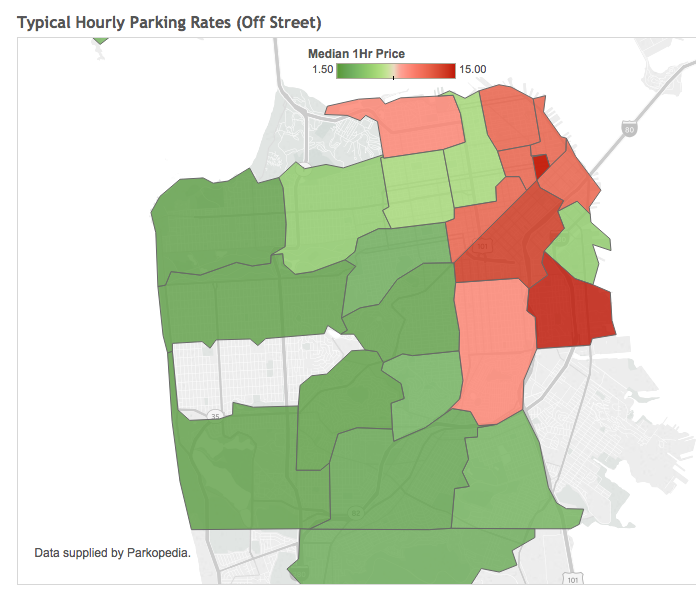What City Observatory did this week
1. Urban Myth Busting: Idling in traffic and carbon pollution. There’s a frequently repeated, just-so story about carbon emissions: if we didn’t spend so much time stuck in stop-and-go traffic and idling, we’d emit less pollution. Highway advocates seize on this idea as an excuse to build more capacity: if we had enough lanes that nobody ever needed to slow down, there’d be less pollution. The problem is adding more capacity, particularly in urban environments simply stimulates induced demand, and generates more driving–and more pollution. A recent study from Portland State University debunks this idle rumor once and for all.
2. Parking prices and ride-hailing use. Ride-hailing companies like Lyft and Uber have been notoriously reluctant to share data on the origins and destinations of their trips. But the San Francisco County Transportation Authority figured out a clever work-around, tapping into the company’s public-facing Application Programming Interfaces (APIs) to track trips. This novel data shows the high concentration of ride-hailing in the city’s urban core–where these trips account for more than a fifth of all traffic at peak hours. We combine this data with information on parking rates to show that patronage of ride-hailing services is highest in areas where parking is most expensive. Its powerful evidence that the way we price parking (and don’t price roads) has profound effects on how people choose to travel. As we’ve suggested before, the advent of ride-hailing (and ultimately, autonomous vehicles) will require that we change the way we price the road system.

3. Pity the poor super commuter. According to some reports, the number of “super commuters”–those traveling more than 90 minutes to work each day is on the rise. In reality, about 2 percent of all US car commuters travel that long daily, a number that’s barely budged in the past decade. Transit riders are about five times as likely as car commuters to endure these long commutes. And arguably many of those who choose long commutes do so to get better access to lower cost housing or amenities, earning a kind of sweat equity by commuting.
Must read
1. California’s failed housing law. For five decades, California law has, at least in theory, required cities to plan for sufficient housing to meet local demand. The state and regional planning agencies estimate population growth and the demand for housing, and set numerical housing goals for each city. The law calls for cities to zone enough land for various types of housing, but in practice, they can easily ignore, or evade the requirements, as the Los Angeles Times explains. Some places zone little or no land for housing, or designate prohibitively expensive or unbuildable areas to receive housing, or rely on discretionary approval processes to block proposed development. Monitoring of compliance is weak–some communities don’t report how many housing units they’ve permitted–and penalties are essentially non-existent. Critics call the existing requirements a waste of time; the State Legislature is considering bills that would add some real teeth.
2. YIMBYs v. Socialists. Another trenchant essay from Slate’s Henry Grabar looks at how the left thinks about housing. As usual, the conflicts are most evident and strident in San Francisco, home of the Bay Area Renter’s Federation (which aggressively advocates for more housing development almost everywhere), and is also home to a growth chapter of the Democratic Socialist of America (who view developers as exploitative bourgeoisie). Both sides agree that the housing market is broken, but are at odds on the practical steps needed to fix things. The irony is that progressive communities like Cambridge, Boulder, Berkeley are the kinds of places that are in high demand, and where development constraints are pushing up the price of housing. We’re looking to see the dialectic at work here; perhaps a new synthesis will emerge on how to tackle our shortage of cities.
3. Parking Placards, Politics and Patronage. Nowhere in North America is parking more valuable than in New York City, and one of the most coveted privileges available is a parking placard that not only allows its bearer to park free at metered spaces, but which effectively enables parking in places that would otherwise be illegal (like in cross walks, next to fire hydrants or in no parking zones). Parking placards are handed out by the Mayor’s Office, as well as other state and local governments. Politico explores who gets placards, from whom, and why.

4. Aetna moves its headquarters to New York City. After more than a century and a half of being headquartered in Hartford, Connecticut, insurance company Aetna is moving its headquarters to Manhattan. The company cited the city’s knowledge economy hub status and access to its deep talent pool as motivation for the move. The company will also get an estimated $30 million in tax breaks. About 250 jobs will move to New York; an estimated 6,000 employees will remain in Hartford.
New ideas
Global Parking Price Comparison. Parkopedia, a web-based directory to parking facilities around the world has developed a list of the most expensive places to park in the world. They’ve compiled data on hourly, daily and monthly parking rates in major cities, and adjusted them for differences in purchasing power parities. London and Sydney are neck and neck at about $57.00 per day for parking (purchasing power parity adjusted). New York ($42), Chicago ($33) and San Francisco ($29) are the priciest US cities for daily parking.

